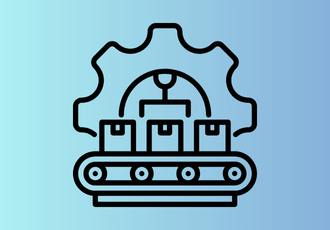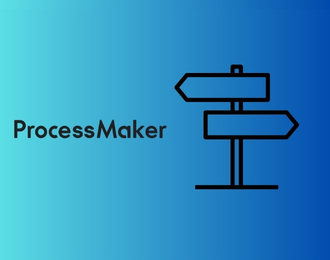Manufacturers today face growing pressures to streamline their operations while enhancing customer satisfaction. Yet, manufacturing companies often struggle with slow customer service processes and manual workflows, which are often prone to errors.
Customer service automation in manufacturing offers a solution to these challenges by streamlining tasks such as order processing, managing inquiries, and addressing complaints.
By leveraging automation tools, manufacturers can minimise human error, enhance operational efficiency, and improve customer satisfaction. Additionally, they can free up human agents to focus on more complex, high-value, and empathetic interactions.
In this blog post, we will explore customer service automation in manufacturing, its benefits, available technologies, and practical implementation. We'll also highlight how FlowForma's no-code platform can optimise your customer service automation with transparent pricing.
What Is Customer Service Automation In Manufacturing?
Customer service automation refers to the use of technology to automate routine customer service tasks, such as answering questions, processing orders, handling complaints, and providing product information.
.png?width=650&height=488&name=Blue%20Gray%20Minimalist%20Circle%20Teamwork%20Infographic%20Presentation%20Graphs%20(31).png)
Customer service automation in manufacturing
In manufacturing, this often involves automating customer-facing backend operations, such as order tracking, shipping updates, invoice issuance, and troubleshooting common issues.
Common customer service automation examples include:
- Providing real-time order status updates for custom parts or large-batch production runs
- Answering frequently asked questions about product specifications, material compatibility, maintenance schedules, or regulatory compliance
- Initiating Level 1 troubleshooting for common machine errors or software glitches
- Logging and intelligently routing complex customer complaints or technical issues to specialised engineering or field service teams
Modern platforms like FlowForma offer an end-to-end solution, allowing manufacturers to build and automate workflows without requiring extensive IT resources.
Essentially, it helps transform fragmented and reactive customer service operations prevalent in manufacturing into an agile, data-driven, and highly responsive system.
Core technologies powering customer service automation in manufacturing
.png?width=675&height=507&name=Blue%20Gray%20Minimalist%20Circle%20Teamwork%20Infographic%20Presentation%20Graphs%20(26).png)
Technologies powering customer service automation in the manufacturing industry
Customer service automation in manufacturing relies on a sophisticated blend of technologies working together seamlessly. Here are the key components that form its technological backbone:
1. Artificial intelligence (AI)
AI acts as the "brain" of automation, enabling systems to make smart decisions, anticipate issues, and even predict potential problems before they arise. This proactive capability is crucial for efficient customer support.
2. Machine Learning (ML) algorithms
These algorithms serve as the learning engine behind the automation. By continuously analysing customer interactions and data, ML algorithms enable the system to learn and refine its support responses over time, resulting in increasingly accurate and helpful interactions.
3. Natural language processing (NLP)
NLP is what makes automated customer service feel human-like. It empowers systems to understand the nuances of customer queries as if they were spoken or written by a person, and then to generate clear, relevant responses in natural language.
4. Cloud-based support platforms
Providing the essential infrastructure, cloud platforms offer the flexibility and scalability needed for modern customer service. They allow manufacturers to expand or contract their support capabilities as demand changes, all while ensuring reliable access.
5. Integration APIs (application programming interfaces)
These are the connectors that tie everything together. APIs facilitate the smooth exchange of information between various systems, databases, and applications, ensuring that all parts of the customer service ecosystem can communicate and share data effortlessly.
Benefits of Customer Service Automation in Manufacturing

Benefits of customer service automation in manufacturing
The adoption of customer service automation in manufacturing comes with several significant benefits:
1. Increased efficiency and reduced response time
Automating repetitive customer service tasks allows manufacturers to provide faster responses to customer inquiries.
Tools like AI-powered chatbots and IVR systems can instantly provide answers to common customer questions, such as order status or product availability. This reduces wait times and ensures that customers receive timely and accurate information.
2. Improved accuracy and reduced errors
Manual processes in customer service often lead to human errors, such as incorrect order processing or missed customer requests.
By automating tasks such as data entry, order fulfilment, and shipping notifications, customer service automation reduces the potential for mistakes, ensuring that customers receive accurate and consistent service.
3. Cost savings and resource optimisation
Automating customer service operations reduces the need for large customer service teams, leading to significant cost savings.
With tools like AI-powered chatbots, manufacturers can handle high volumes of customer interactions without adding additional staff. This enables manufacturers to reallocate resources to more complex tasks that require human intervention.
4. Enhanced customer experience
By addressing customer needs promptly through automated systems, manufacturers can significantly improve customer satisfaction and foster loyalty.
Additionally, customer service automation ensures that customers receive 24/7 support, which is essential for manufacturers catering to global markets.
5. Scalability for growth
As manufacturers grow, their customer service operations must scale accordingly. Customer service automation enables businesses to handle larger volumes of customer interactions without adding significant overhead.
Automated systems can be easily scaled to meet increased demand, providing manufacturers with the flexibility to expand operations seamlessly.
6. Reduced agent burnout and turnover
Far from replacing customer service agents, automation empowers them.
By offloading routine tasks, agents can focus their energy on complex issues requiring empathy, critical thinking, and nuanced problem-solving. This shift to more meaningful work often leads to increased job satisfaction and a reduction in burnout.
Types of Automation Technologies in Manufacturing Customer Service
To effectively implement customer service automation, manufacturers can leverage several technologies designed to optimise their customer service processes. These tools range from basic chatbots to advanced AI solutions..png?width=650&height=488&name=Blue%20Gray%20Minimalist%20Circle%20Teamwork%20Infographic%20Presentation%20Graphs%20(27).png)
Types of automation technologies in manufacturing
Here are the key types of automation technologies enhancing customer service in manufacturing:
1. Workflow automation
Instead of manually forwarding emails, updating spreadsheets, or making phone calls to different departments (e.g., sales, production, logistics, engineering) to resolve a customer issue, workflow automation ensures tasks are automatically routed to the right person or system at the right time.
With FlowForma's no-code workflow builder, manufacturing teams can quickly design and deploy these critical processes, integrating seamlessly with existing systems via its APIs to connect production, sales, and logistics data.

Create seamless customer service workflows in manufacturing with FlowForma
For instance, manufacturers can quickly build automated processes for real-time order status or return updates by integrating with ERP/inventory systems.
2. AI-powered chatbots
AI-powered chatbots are among the most widely used automation tools in customer service. These provide instant, 24/7 support for routine manufacturing queries like lead times.
3. Robotic process automation (RPA)
RPA automates backend processes such as order processing, invoicing, and customer data management. This technology allows manufacturers to automate repetitive, rule-based tasks, improving accuracy and speed.
4. Digital forms and intelligent data capture
Accurate and immediate data input from customers or internal teams is crucial. For manufacturing, this involves capturing precise product serial numbers, machine models, error codes, quality control details, and custom order specifications directly and digitally.
Tools like FlowForma provide smart digital forms that are fully customisable, mobile-friendly, and can include dynamic fields, validation rules, and conditional logic.
Capture data with FlowForma’s forms
5. Automated ticket routing
Utilises rules or AI to analyse incoming customer inquiries (tickets) and automatically assign them to the most appropriate agent or department.
FlowForma offers end-to-end process management and designs intelligent workflows
FlowForma supercharges this process through the use of AI Copilot and a drag-and-drop builder that allows users to design intelligent routing rules quickly. This means incoming customer inquiries (such as machine component issues or billing questions) are automatically directed to the correct, specialised technical support team or department.
How FlowForma Helps Customer Service Automation in Manufacturing
FlowForma’s platform offers a powerful, no-code solution for automating customer service operations in manufacturing. By enabling businesses to build custom workflows, FlowForma allows manufacturers to automate key customer-facing processes such as order tracking, complaint resolution, and feedback collection, without needing extensive IT expertise.
1. No-code workflow design
One of FlowForma’s key advantages is its no-code platform, which enables manufacturers to automate customer service workflows without requiring technical expertise.

FlowForma platform demo
Businesses can design, implement, and scale automation processes in-house, significantly reducing the time and cost associated with IT-driven automation projects.
2. AI-powered process design
FlowForma leverages AI Copilot to transform customer service automation in manufacturing, enabling faster, more specialised handling.
With AI Copilot, users can describe the desired workflows (e.g., new machinery support), and the Copilot instantly generates a foundational automation structure.
This significantly accelerates the development and deployment of new customer service automations, enabling manufacturers to respond quickly to evolving demands.
Try our AI Copilot playground to explore how you can automate business processes within seconds.

FlowForma AI Copilot playground
3. Intelligent automation with Agentic AI
Beyond basic automation, FlowForma's workflows, enhanced with Agentic AI principles, can intelligently analyse incoming customer requests.
AI automation workflow masterclass
For instance, if a customer's language suggests high frustration or if they have a history of unresolved issues, the system can automatically flag the case as high-risk.
This allows FlowForma to dynamically override standard queues and intelligently route the issue to a senior agent or manager for immediate, prioritised attention, ensuring proactive and empathetic handling of critical manufacturing customer relationships.
4. Seamless integration with existing systems
FlowForma offers seamless integration with existing CRM, ERP, and other business systems, enabling manufacturers to automate customer service processes without disrupting their current operations.

This integration ensures that customer data remains consistent across all systems, improving service quality and efficiency.
5. Automated document generation
Automating the generation of invoices, shipping labels, and compliance documentation reduces manual effort and ensures that all documents are accurate and generated in real-time.
FlowForma’s document automation feature allows manufacturers to quickly generate standardised documents, improving efficiency and ensuring consistency in their communication with customers.
6. Insights for success measurement
To ensure that customer service automation is delivering the desired results, manufacturers must track key performance indicators (KPIs) such as response times, customer satisfaction, and issue resolution rates.
Automated systems, such as FlowForma, provide valuable insights into these metrics, helping businesses identify areas for improvement.

By measuring success and continuously refining their approach, manufacturers can ensure that their customer service automation strategies evolve in line with customer expectations.
7. Process-based pricing
FlowForma employs a transparent, process-based pricing model designed to offer clear costs without hidden fees.
This allows manufacturers to scale their digital transformation efforts, knowing that as they automate a high volume of transactions, they won't face unexpected or escalating costs.
Real-world example: How Nipro Europe leveraged automation for enhanced manufacturing customer service
How Nipro leveraged automation for enhanced operational efficiency
Nipro Europe, a large medical device manufacturer, faced challenges with unstandardised processes across more than 90 locations and the high cost of traditional IT solutions, which impacted operational efficiency.
FlowForma helped by digitising and automating key operations, enabling process standardisation across its global network. It made previously cost-prohibitive automations feasible and significantly improved communication with external parties, including clients, by involving them directly in digital workflows.
By creating a more efficient internal backbone, Nipro now handles inquiries and service requests more consistently and quickly.
Streamlining digital interactions with clients through shared processes leads to faster resolutions and improved customer satisfaction within their complex industrial context.
Steps to Implement Customer Service Automation in Manufacturing
.png?width=650&height=488&name=Blue%20Gray%20Minimalist%20Circle%20Teamwork%20Infographic%20Presentation%20Graphs%20(29).png)
Steps to automate customer service in the manufacturing sector
Begin by identifying the key pain points in your current customer service process. Look for areas that can be automated, such as order processing, customer feedback collection, or complaint management.
1. Choose the right tool
Select a platform that aligns with your specific needs. Look for solutions that offer robust integration capabilities with your existing ERP, CRM, and other systems.
A no-code/low-code platform, such as FlowForma, is particularly advantageous as it empowers business users to build and deploy solutions rapidly, significantly reducing reliance on IT departments and accelerating time-to-value.
2. Carry out phased implementation
Avoid trying to automate everything at once. Start with high-impact, low-complexity processes that offer quick wins (e.g., FAQs, order status checks). Implement in phases, allowing for learning and iterative improvement based on real-world feedback. Pilot programs are excellent for testing the waters.
3. Provide proactive support and training
Automation represents a significant shift for employees. It's vital to communicate the benefits clearly, prepare teams for the new way of working, and provide comprehensive training. Agents need to understand how to work effectively alongside AI tools, evolving into roles that demand higher-level problem-solving and empathy.
4. Monitor and optimise
Continuously monitor the performance of your automation tools. Collect feedback from customers and employees to identify areas for improvement and optimise your processes accordingly.
Empower Manufacturing Teams with FlowForma

Why manufacturers choose FlowForma
Customer service automation in manufacturing is a critical tool for improving operational efficiency, reducing costs, and enhancing customer satisfaction.
With FlowForma’s no-code platform, manufacturers can easily automate their customer service processes without requiring significant IT resources.
With transparent pricing and seamless system integration, FlowForma is a top choice for manufacturers looking to enhance their customer service operations.
Ready to optimise your customer service? Book a demo with FlowForma today to discover how automation can improve your efficiency and customer satisfaction.
FAQs
How do customer service automation tools improve manufacturing operations?
By automating routine tasks, manufacturers can reduce response times, improve accuracy, lower costs, and provide 24/7 support to customers. This helps businesses scale operations while maintaining a high level of customer service.
How can FlowForma help with customer service automation?
FlowForma offers a no-code platform that enables manufacturers to automate their customer service workflows. It integrates seamlessly with existing systems, offers AI-powered chatbots, and provides transparent pricing with no hidden costs.
What are the types of automation technology used in customer service in manufacturing?
Common technologies include AI chatbots, IVR systems, RPA, and automated ticketing systems. These tools help manufacturers handle routine tasks, allowing human agents to focus on more complex issues.
How do I choose the right automated customer service software?
Choosing the right customer service automation software requires strategic thinking. Here are a few things you should remember:
- Prioritise scalability and flexibility to meet the future demands of your business
- Ease of use with no-code capabilities is crucial, empowering non-technical staff to build and manage automations efficiently
- Look for seamless integration with existing CRM, ERP, and order management systems
- Evaluate the vendor's customer support and training resources
- The tool should offer a clear, transparent pricing model to ensure long-term value
.png) By
By 




